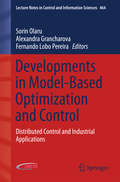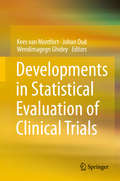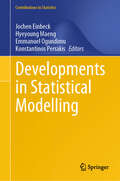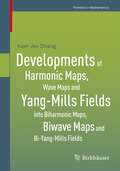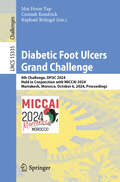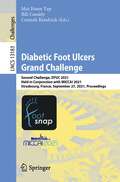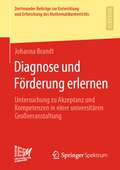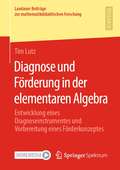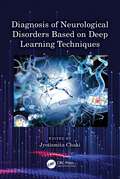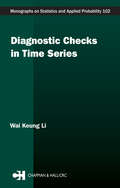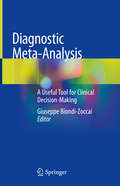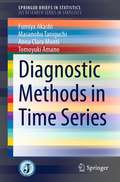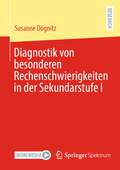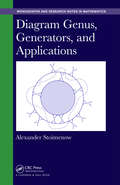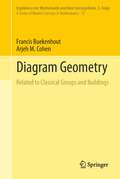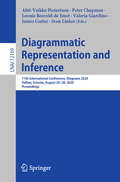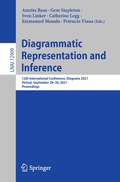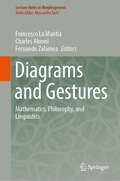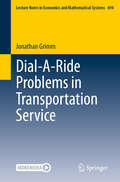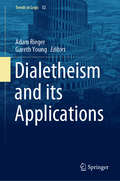- Table View
- List View
Developments in Microbial Bioremediation: A Guide for Sustainable Waste Treatment (SpringerBriefs in Molecular Science)
by Pratima BajpaiThis book sheds new light on the transformative role of microorganisms in waste management, offering a comprehensive overview of microbial waste management strategies and their applications. Through this book, readers will learn about the latest advancements in bioremediation and microbial consortia technology, providing a fresh perspective on sustainable waste treatment solutions. The chapters cover topics such as the types and origins of waste, the importance of microorganisms in various waste management processes, and the benefits of bioremediation compared to traditional methods. Readers will discover diverse strategies for managing microbial waste, including bioleaching, bioaugmentation, and utilizing microorganisms to aid phytoremediation. The book also discusses the combined use of bacteria and microalgae for wastewater treatment and emerging innovations in microbial consortia technology. Critical attention is given to the role of microbes in multiple industrial applications such as pharmaceuticals, food processing, textiles, explosives, distilleries, and petrochemicals. Additionally, it explores bioinformatics approaches like genomics and proteomics that drive bioremediation efforts. This volume is an essential resource for researchers in environmental science, biotechnology professionals focusing on sustainable practices, scholars studying advanced wastewater treatment methods using nanotechnology or plant species integration with microorganisms. It invites readers to think through critical questions about sustainable waste treatment practices while offering valuable insights into future perspectives on microbial waste management.
Developments in Model-Based Optimization and Control
by Sorin Olaru Alexandra Grancharova Fernando Lobo PereiraThis book deals with optimization methods as tools for decision making and control in the presence of model uncertainty. It is oriented to the use of these tools in engineering, specifically in automatic control design with all its components: analysis of dynamical systems, identification problems, and feedback control design. Developments in Model-Based Optimization and Control takes advantage of optimization-based formulations for such classical feedback design objectives as stability, performance and feasibility, afforded by the established body of results and methodologies constituting optimal control theory. It makes particular use of the popular formulation known as predictive control or receding-horizon optimization. The individual contributions in this volume are wide-ranging in subject matter but coordinated within a five-part structure covering material on: · complexity and structure in model predictive control (MPC); · collaborative MPC; · distributed MPC; · optimization-based analysis and design; and · applications to bioprocesses, multivehicle systems or energy management. The various contributions cover a subject spectrum including inverse optimality and more modern decentralized and cooperative formulations of receding-horizon optimal control. Readers will find fourteen chapters dedicated to optimization-based tools for robustness analysis, and decision-making in relation to feedback mechanisms--fault detection, for example--and three chapters putting forward applications where the model-based optimization brings a novel perspective. Developments in Model-Based Optimization and Control is a selection of contributions expanded and updated from the Optimisation-based Control and Estimation workshops held in November 2013 and November 2014. It forms a useful resource for academic researchers and graduate students interested in the state of the art in predictive control. Control engineers working in model-based optimization and control, particularly in its bioprocess applications will also find this collection instructive.
Developments in Nonstandard Mathematics
by Nigel J Cutland Vitor Neves A F Oliveira Jose Sousa-PintoThis book contains expository papers and articles reporting on recent research by leading world experts in nonstandard mathematics, arising from the International Colloquium on Nonstandard Mathematics held at the University of Aveiro, Portugal in July 1994. Nonstandard mathematics originated with Abraham Robinson, and the body of ideas that have developed from this theory of nonstandard analysis now vastly extends Robinson's work with infinitesimals. The range of applications includes measure and probability theory, stochastic analysis, differential equations, generalised functions, mathematical physics and differential geometry, moreover, the theory has implicaitons for the teaching of calculus and analysis. This volume contains papers touching on all of the abovbe topics, as well as a biographical note about Abraham Robinson based on the opening address given by W.A>J> Luxemburg - who knew Robinson - to the Aveiro conference which marked the 20th anniversary of Robinson's death. This book will be of particular interest to students and researchers in nonstandard analysis, measure theory, generalised functions and mathematical physics.
Developments in Statistical Evaluation of Clinical Trials
by Kees Van Montfort Johan Oud Wendimagegn GhideyThis book describes various ways of approaching and interpreting the data produced by clinical trial studies, with a special emphasis on the essential role that biostatistics plays in clinical trials. Over the past few decades the role of statistics in the evaluation and interpretation of clinical data has become of paramount importance. As a result the standards of clinical study design, conduct and interpretation have undergone substantial improvement. The book includes 18 carefully reviewed chapters on recent developments in clinical trials and their statistical evaluation, with each chapter providing one or more examples involving typical data sets, enabling readers to apply the proposed procedures. The chapters employ a uniform style to enhance comparability between the approaches.
Developments in Statistical Modelling (Contributions to Statistics)
by Jochen Einbeck Hyeyoung Maeng Emmanuel Ogundimu Konstantinos PerrakisThis volume on the latest developments in statistical modelling is a collection of refereed papers presented at the 38th International Workshop on Statistical Modelling, IWSM 2024, held from 14 to 19 July 2024 in Durham, UK. The contributions cover a wide range of topics in statistical modelling, including generalized linear models, mixture models, regularization techniques, hidden Markov models, smoothing methods, censoring and imputation techniques, Gaussian processes, spatial statistics, shape modelling, goodness-of-fit problems, and network analysis. Various highly topical applications are presented as well, especially from biostatistics. The approaches are equally frequentist and Bayesian, a categorization the statistical modelling community has synergetically overcome. The book also features the workshop’s keynote contribution on statistical modelling for big and little data, highlighting that both small and large data sets come with their own challenges. The International Workshop on Statistical Modelling (IWSM) is the annual workshop of the Statistical Modelling Society, with the purpose of promoting important developments, extensions, and applications in statistical modelling, and bringing together statisticians working on related problems from various disciplines. This volume reflects this spirit and contributes to initiating and sustaining discussions about problems in statistical modelling and triggers new developments and ideas in the field.
Developments of Harmonic Maps, Wave Maps and Yang-Mills Fields into Biharmonic Maps, Biwave Maps and Bi-Yang-Mills Fields
by Yuan-Jen ChiangHarmonic maps between Riemannian manifolds were first established by James Eells and Joseph H. Sampson in 1964. Wave maps are harmonic maps on Minkowski spaces and have been studied since the 1990s. Yang-Mills fields, the critical points of Yang-Mills functionals of connections whose curvature tensors are harmonic, were explored by a few physicists in the 1950s, and biharmonic maps (generalizing harmonic maps) were introduced by Guoying Jiang in 1986. The book presents an overview of the important developments made in these fields since they first came up. Furthermore, it introduces biwave maps (generalizing wave maps) which were first studied by the author in 2009, and bi-Yang-Mills fields (generalizing Yang-Mills fields) first investigated by Toshiyuki Ichiyama, Jun-Ichi Inoguchi and Hajime Urakawa in 2008. Other topics discussed are exponential harmonic maps, exponential wave maps and exponential Yang-Mills fields.
Diabetic Foot Ulcers Grand Challenge: 4th Challenge, DFUC 2024, Held in Conjunction with MICCAI 2024, Marrakesh, Morocco, October 6, 2024, Proceedings (Lecture Notes in Computer Science #15335)
by Moi Hoon Yap Connah Kendrick Raphael BrüngelThis book constitutes the 4th Challenge on Diabetic Foot Ulcers, DFUC2024, held in conjunction with the 27th International Conference on Medical Image Computing and Computer-Assisted Intervention, MICCAI 2024, in Marrakesh, Morocco, on October 6, 2024. The 8 full papers presented in this book together with 2 invited papers were carefully reviewed and selected from 11 submissions. The task of DFUC 2024 was on self-supervised learning in ulcer segmentation, for the purpose of supporting research towards more advanced methods to overcome data deficiency and unlabelled data.
Diabetic Foot Ulcers Grand Challenge: Second Challenge, DFUC 2021, Held in Conjunction with MICCAI 2021, Strasbourg, France, September 27, 2021, Proceedings (Lecture Notes in Computer Science #13183)
by Moi Hoon Yap Bill Cassidy Connah KendrickThis book constitutes the Second Diabetic Foot Ulcers Grand Challenge, DFUC 2021, which was held on September 27, 2021, in conjunction with the 24th International Conference on Medical Image Computing and Computer-Assisted Intervention, MICCAI 2021. The challenge took place virtually due to the COVID-19 pandemic.The 6 full papers included in this book were carefully reviewed and selected from 14 submissions. There is also an overview paper on the challenge and datasets and one summary paper of DFUC 2021.
Diagnose und Förderung erlernen: Untersuchung zu Akzeptanz und Kompetenzen in einer universitären Großveranstaltung (Dortmunder Beiträge zur Entwicklung und Erforschung des Mathematikunterrichts #49)
by Johanna BrandtDie Entwicklung von Diagnose- und Förderkompetenzen ist in der fachdidaktischen Ausbildung angehender Lehrkräfte von zentraler Bedeutung. Johanna Brandt untersucht vor diesem Hintergrund die Konzeption einer Lernumgebung zum Erlernen von Diagnose und Förderung im Rahmen einer mathematikdidaktischen Großveranstaltung. Forschungsschwerpunkte der Untersuchung im Mixed-Methods-Design bilden die Akzeptanz der Studierenden gegenüber aktivierenden und fallbasierten Maßnahmen sowie die Entwicklung ihrer Kompetenzen im Bereich ‚Diagnose und Förderung‘. Die Autorin generiert mögliche akzeptanzbeeinflussende Faktoren hochschuldidaktischer Maßnahmen und zeigt, dass es auch im Rahmen einer universitären Großveranstaltung mit dreistelliger Teilnehmendenzahl möglich ist, Diagnose- und Förderkompetenzen praxisnah zu entwickeln.
Diagnose und Förderung in der elementaren Algebra: Entwicklung eines Diagnoseinstrumentes und Vorbereitung eines Förderkonzeptes (Landauer Beiträge zur mathematikdidaktischen Forschung)
by Tim LutzDieser Band berichtet die Ergebnisse des Projektes aldiff, das sich mit der Erstellung automatisiert auswertbarer Diagnose- und Fördermaterialien am Übergang Schule-Hochschule beschäftigt. Kenntnisse der elementaren Algebra sind zentrale Befähigungsvoraussetzungen für Studierende des Bereichs MINT. Universitäten und Hochschulen bereiten seit Langem Studenten in eigens konzipierten Vorbereitungs- und Unterstützungskursen studienbegleitend vor. Bislang steht dabei eher die Vermittlung "kalküllastiger" Fertigkeiten im Vordergrund als die Erlangung verstehensorientierter Fähigkeiten. An dieser Problematik setzt das Projekt aldiff mit fachdidaktischer Forschung an. Auf Basis eines theoretischen Fähigkeitsmodells für die elementare Algebra und eines Aufgabenpools werden empirische Modelle entwickelt. Das vorgeschlagene Förderkonzept ermöglicht differenzierende adaptive Unterstützungsmaßnahmen zum Einsatz am Übergang Schule-Hochschule.
Diagnosis of Neurological Disorders Based on Deep Learning Techniques
by Jyotismita ChakiThis book is based on deep learning approaches used for the diagnosis of neurological disorders, including basics of deep learning algorithms using diagrams, data tables, and practical examples, for diagnosis of neurodegenerative and neurodevelopmental disorders. It includes application of feed-forward neural networks, deep generative models, convolutional neural networks, graph convolutional networks, and recurrent neural networks in the field of diagnosis of neurological disorders. Along with this, data preprocessing including scaling, correction, trimming, and normalization is also included. Offers a detailed description of the deep learning approaches used for the diagnosis of neurological disorders. Demonstrates concepts of deep learning algorithms using diagrams, data tables, and examples for the diagnosis of neurodegenerative, neurodevelopmental, and psychiatric disorders. Helps build, train, and deploy different types of deep architectures for diagnosis. Explores data preprocessing techniques involved in diagnosis. Includes real-time case studies and examples. This book is aimed at graduate students and researchers in biomedical imaging and machine learning.
Diagnosis, Fault Detection & Tolerant Control (Studies in Systems, Decision and Control #269)
by Quanmin Zhu Nabil Derbel Jawhar GhommamThis book focuses on unhealthy cyber-physical systems. Consisting of 14 chapters, it discusses recognizing the beginning of the fault, diagnosing the appearance of the fault, and stopping the system or switching to a special control mode known as fault-tolerant control. Each chapter includes the background, motivation, quantitative development (equations), and case studies/illustration/tutorial (simulations, experiences, curves, tables, etc.). Readers can easily tailor the techniques presented to accommodate their ad hoc applications.
Diagnostic Checks in Time Series (Chapman And Hall/crc Monographs On Statistics And Applied Probability Ser. #102)
by Wai Keung LiDiagnostic checking is an important step in the modeling process. But while the literature on diagnostic checks is quite extensive and many texts on time series modeling are available, it still remains difficult to find a book that adequately covers methods for performing diagnostic checks.Diagnostic Checks in Time Series helps to fill that
Diagnostic Meta-Analysis: A Useful Tool for Clinical Decision-Making
by Giuseppe Biondi-ZoccaiThis book is the first exclusively devoted to the systematic synthesis of diagnostic test accuracy studies. It builds upon the major recent developments in reporting standards, search methods, and, in particular, statistical tools specifically devoted to diagnostic studies. In addition, it borrows extensively from the latest advances in systematic reviews and meta-analyses of intervention studies. After a section dedicated to methods for designing reviews, synthesizing evidence and appraising inconsistency in research, the application of these approaches is demonstrated in the context of case studies from various clinical disciplines. Diagnosis is central in medical decision-making, and in many other fields of human endeavor, such as education and psychology. The plurality of sources of evidence on diagnostic test accuracy poses a huge challenge for practitioners and researchers, as do the multiple dimensions of evidence validity, which include sensitivity, specificity, predictive values, and likelihood ratios. This book offers an invaluable resource for anyone aiming to improve decision-making processes in diagnosis, classification or risk prognostication, from epidemiologists to biostatisticians, radiologists, laboratory physicians and graduate students, as any physician interested in refining his methodological skills in clinical diagnosis.
Diagnostic Methods in Time Series (SpringerBriefs in Statistics)
by Masanobu Taniguchi Tomoyuki Amano Fumiya Akashi Anna Clara MontiThis book contains new aspects of model diagnostics in time series analysis, including variable selection problems and higher-order asymptotics of tests. This is the first book to cover systematic approaches and widely applicable results for nonstandard models including infinite variance processes. The book begins by introducing a unified view of a portmanteau-type test based on a likelihood ratio test, useful to test general parametric hypotheses inherent in statistical models. The conditions for the limit distribution of portmanteau-type tests to be asymptotically pivotal are given under general settings, and very clear implications for the relationships between the parameter of interest and the nuisance parameter are elucidated in terms of Fisher-information matrices. A robust testing procedure against heavy-tailed time series models is also constructed in the context of variable selection problems. The setting is very reasonable in the context of financial data analysis and econometrics, and the result is applicable to causality tests of heavy-tailed time series models. In the last two sections, Bartlett-type adjustments for a class of test statistics are discussed when the parameter of interest is on the boundary of the parameter space. A nonlinear adjustment procedure is proposed for a broad range of test statistics including the likelihood ratio, Wald and score statistics.
Diagnostik von besonderen Rechenschwierigkeiten in der Sekundarstufe I
by Susanne DögnitzObwohl PISA 2018 bei 21% der 14-Jährigen Defizite im basismathematischen Bereich feststellte, ist das Thema Rechenschwäche vorrangig eines der Grundschulforschung. In diesem Buch wird die Entwicklung eines nach IRT konzipierten Gruppentestverfahrens (LeDi-Arithmetik) aufgezeigt, das es Lehrkräften der Sek. I ermöglicht, mangelnde mathematische Basiskompetenzen zu erkennen. Das Testergebnis lässt eine Einordnung in Kompetenzstufen zu, die für potentiell rechenschwache Schüler*innen Ausgangspunkt einer Individualdiagnostik sein kann. Anhand von bisher publizierten Studien zu Fähigkeiten rechenschwacher Lernender sowie Entwicklungsmodellen arithmetischer Kompetenzen wurden spezifische Inhalte identifiziert und zum Teil durch verstehensorientierte Aufgabenformate, wie sie in standardisierten Tests kaum zu finden sind, umgesetzt. Auch wurden Aufgaben zu gebrochenen Zahlen konzipiert, deren Ergebnisse bei unklarer Diagnostik im Bereich der natürlichen Zahlen, herangezogen werden können. Die Analyse von 400 Schülerlösungen zeigt auf, welche Aufgabeninhalte sich zur Diagnostik im Klassenverband eignen, welcher Stellenwert verstehensorientierten Aufgaben zukommt und wie diese unter Einhaltung der Gütekriterien psychometrischer Tests verwendet werden können.
Diagram Genus, Generators, and Applications (Chapman & Hall/CRC Monographs and Research Notes in Mathematics)
by Alexander StoimenowIn knot theory, diagrams of a given canonical genus can be described by means of a finite number of patterns ("generators"). Diagram Genus, Generators and Applications presents a self-contained account of the canonical genus: the genus of knot diagrams. The author explores recent research on the combinatorial theory of knots and supplies proofs for a number of theorems. The book begins with an introduction to the origin of knot tables and the background details, including diagrams, surfaces, and invariants. It then derives a new description of generators using Hirasawa’s algorithm and extends this description to push the compilation of knot generators one genus further to complete their classification for genus 4. Subsequent chapters cover applications of the genus 4 classification, including the braid index, polynomial invariants, hyperbolic volume, and Vassiliev invariants. The final chapter presents further research related to generators, which helps readers see applications of generators in a broader context.
Diagram Geometry: Related to Classical Groups and Buildings
by Arjeh M. Cohen Francis BuekenhoutThis book provides a self-contained introduction to diagram geometry. Tight connections with group theory are shown. It treats thin geometries (related to Coxeter groups) and thick buildings from a diagrammatic perspective. Projective and affine geometry are main examples. Polar geometry is motivated by polarities on diagram geometries and the complete classification of those polar geometries whose projective planes are Desarguesian is given. It differs from Tits' comprehensive treatment in that it uses Veldkamp's embeddings. The book intends to be a basic reference for those who study diagram geometry. Group theorists will find examples of the use of diagram geometry. Light on matroid theory is shed from the point of view of geometry with linear diagrams. Those interested in Coxeter groups and those interested in buildings will find brief but self-contained introductions into these topics from the diagrammatic perspective. Graph theorists will find many highly regular graphs. The text is written so graduate students will be able to follow the arguments without needing recourse to further literature. A strong point of the book is the density of examples.
Diagrammatic Representation and Inference: 10th International Conference, Diagrams 2018, Edinburgh, UK, June 18-22, 2018, Proceedings (Lecture Notes in Computer Science #10871)
by Peter Chapman Amirouche Moktefi Gem Stapleton Sarah Perez-Kriz Francesco BellucciThis book constitutes the refereed proceedings of the 10th International Conference on the Theory and Application of Diagrams, Diagrams 2018, held in Edinburgh, UK, in June 2018.The 26 revised full papers and 28 short papers presented together with 32 posters were carefully reviewed and selected from 124 submissions. The papers are organized in the following topical sections: generating and drawing Euler diagrams; diagrams in mathematics; diagram design, principles and classification; reasoning with diagrams; Euler and Venn diagrams; empirical studies and cognition; Peirce and existential graphs; and logic and diagrams.
Diagrammatic Representation and Inference: 11th International Conference, Diagrams 2020, Tallinn, Estonia, August 24–28, 2020, Proceedings (Lecture Notes in Computer Science #12169)
by Peter Chapman Ahti-Veikko Pietarinen Leonie Bosveld-de Smet Valeria Giardino James Corter Sven LinkerThis book constitutes the refereed proceedings of the 11th International Conference on the Theory and Application of Diagrams, Diagrams 2020, held in Tallinn, Estonia, in August 2020.*The 20 full papers and 16 short papers presented together with 18 posters were carefully reviewed and selected from 82 submissions. The papers are organized in the following topical sections: diagrams in mathematics; diagram design, principles, and classification; reasoning with diagrams; Euler and Venn diagrams; empirical studies and cognition; logic and diagrams; and posters. *The conference was held virtually due to the COVID-19 pandemic. The chapters ‘Modality and Uncertainty in Data Visualization: A Corpus Approach to the Use of Connecting Lines,’ ‘On Effects of Changing Multi-Attribute Table Design on Decision Making: An Eye Tracking Study,’ ‘Truth Graph: A Novel Method for Minimizing Boolean Algebra Expressions by Using Graphs,’ ‘The DNA Framework of Visualization’ and ‘Visualizing Curricula’ are available open access under a Creative Commons Attribution 4.0 International License via link.springer.com.
Diagrammatic Representation and Inference: 12th International Conference, Diagrams 2021, Virtual, September 28–30, 2021, Proceedings (Lecture Notes in Computer Science #12909)
by Amrita Basu Gem Stapleton Emmanuel Manalo Sven Linker Catherine Legg Petrucio VianaThis book constitutes the refereed proceedings of the 12th International Conference on the Theory and Application of Diagrams, Diagrams 2021, held virtually in September 2021. The 16 full papers and 25 short papers presented together with 16 posters were carefully reviewed and selected from 94 submissions. The papers are organized in the following topical sections: design of concrete diagrams; theory of diagrams; diagrams and mathematics; diagrams and logic; new representation systems; analysis of diagrams; diagrams and computation; cognitive analysis; diagrams as structural tools; formal diagrams; and understanding thought processes. 10 chapters are available open access under a Creative Commons Attribution 4.0 International License via link.springer.com.
Diagrams and Gestures: Mathematics, Philosophy, and Linguistics (Lecture Notes in Morphogenesis)
by Fernando Zalamea Francesco La Mantia Charles AlunniDrawing a line, and then another, and another. Go back from the lines to the movements they capture and see gestures in them: not spatial displacements, but modes of knowledge that pass through the exercise of the body. Discovering something new in a gesture: the line that contracts into a point or the point that expands into a zone, perhaps sinking into a hole. Thus experiencing a diagram: a becoming other inscribed in the novelty of the gesture and in the changes of the forms it shapes. This and much more is discussed in the essays gathered in Diagrams and Gestures. Resulting from trans-disciplinary work between mathematicians, philosophers, linguists and semioticians, the volume delivers an up-to-date account of the most valuable research on the connections between gesture and diagram. As one of the most important themes in contemporary thought, the study of these connections poses a challenge for the future: to elaborate a theory that is equal to new and stimulating research methodologies. We call this theory a philosophy of diagrammatic gestures.
Diagrams, Visual Imagination, and Continuity in Peirce's Philosophy of Mathematics (Mathematics in Mind)
by Vitaly KiryushchenkoThis book is about the relationship between necessary reasoning and visual experience in Charles S. Peirce’s mathematical philosophy. It presents mathematics as a science that presupposes a special imaginative connection between our responsiveness to reasons and our most fundamental perceptual intuitions about space and time. Central to this view on the nature of mathematics is Peirce’s idea of diagrammatic reasoning. In practicing this kind of reasoning, one treats diagrams not simply as external auxiliary tools, but rather as immediate visualizations of the very process of the reasoning itself. Thus conceived, one's capacity to diagram their thought reveals a set of characteristics common to ordinary language, visual perception, and necessary mathematical reasoning. The book offers an original synthetic approach that allows tracing the roots of Peirce’s conception of a diagram in certain patterns of interrelation between his semiotics, his pragmaticist philosophy, his logical and mathematical ideas, bits and pieces of his biography, his personal intellectual predispositions, and his scientific practice as an applied mathematician.
Dial-A-Ride Problems in Transportation Service (Lecture Notes in Economics and Mathematical Systems #694)
by Jonathan GrimmAlthough the dial-a-ride problem currently plays a crucial role in providing transportation services to specific demographics such as the elderly, those with serious illnesses, or individuals with limited mobility due to disabilities, its potential impact on the overall mobility of the population remains underexplored. Surprisingly, the focus is often narrow, leaving potentials untapped and negatively impacting service providers’ profitability. This book proposes several solutions, including strategies for increasing revenue, offering supplementary services, and fostering collaboration. Further, it presents ideas and approaches that address the corresponding problems using operations research methods. The proposals presented here can be used not only to enhance the economic viability of dial-a-ride systems but also boost their impact and visibility. As such, the book shares fundamental insights into solving the dial-a-ride problem and anticipates future trends, leading the way to new frontiers of research. The book offers a valuable resource for academics and professionals engaged in the field of transportation or those interested in the design and development of advanced mathematical programming techniques.
Dialetheism and its Applications (Trends in Logic #52)
by Adam Rieger Gareth YoungThe purpose of this book is to present unpublished papers at the cutting edge of research on dialetheism and to reflect recent work on the applications of the theory. It includes contributions from some of the most respected scholars in the field, as well as from young, up-and-coming philosophers working on dialetheism.Moving from the fringes of philosophy to become a main player in debates concerning truth and the logical paradoxes, dialetheism has thrived since the publication of Graham Priest’s In Contradiction, and several of the papers find their roots in a conference on dialetheism held in Glasgow to mark the 25th anniversary of Priest’s book. The content presented here demonstrates the considerable body of work produced in this field in recent years.With a broad focus, this book also addresses the applications of dialetheism outside the more familiar area of the logical paradoxes, and includes pieces discussing the application of dialetheism in metaphysics, philosophy of language, and philosophy of mind.

